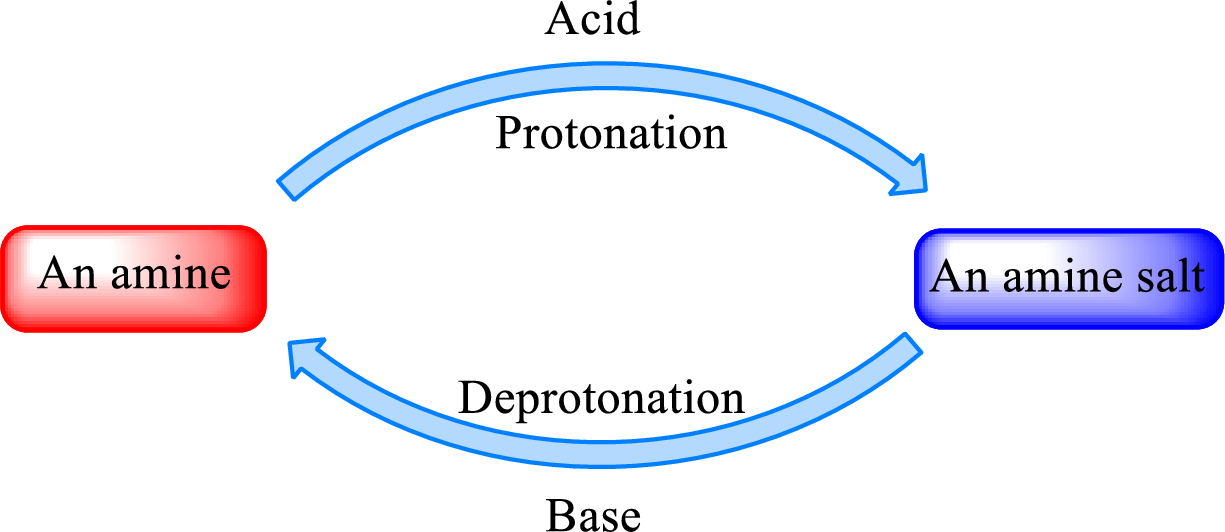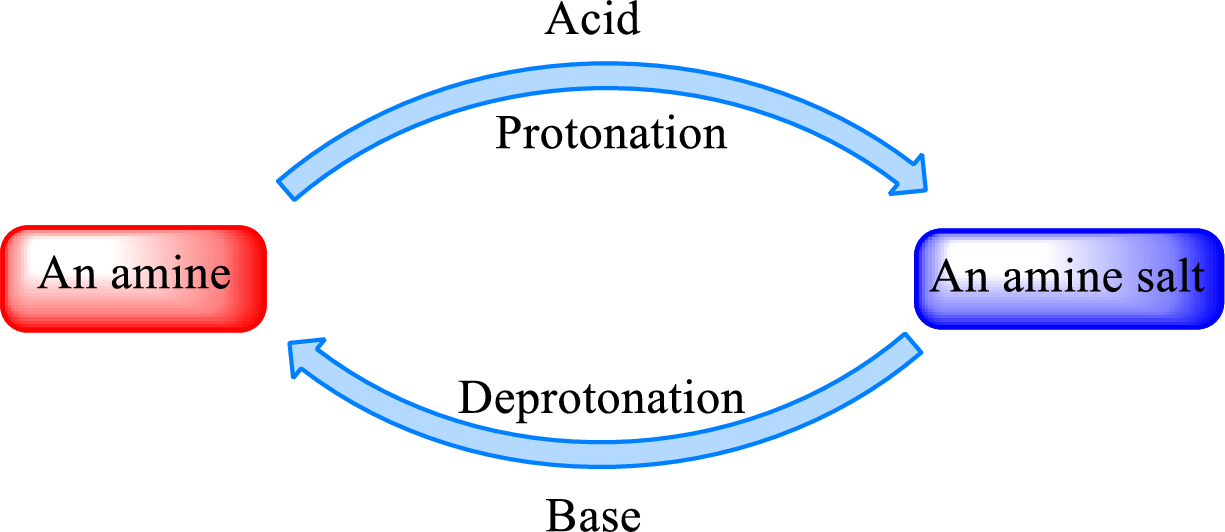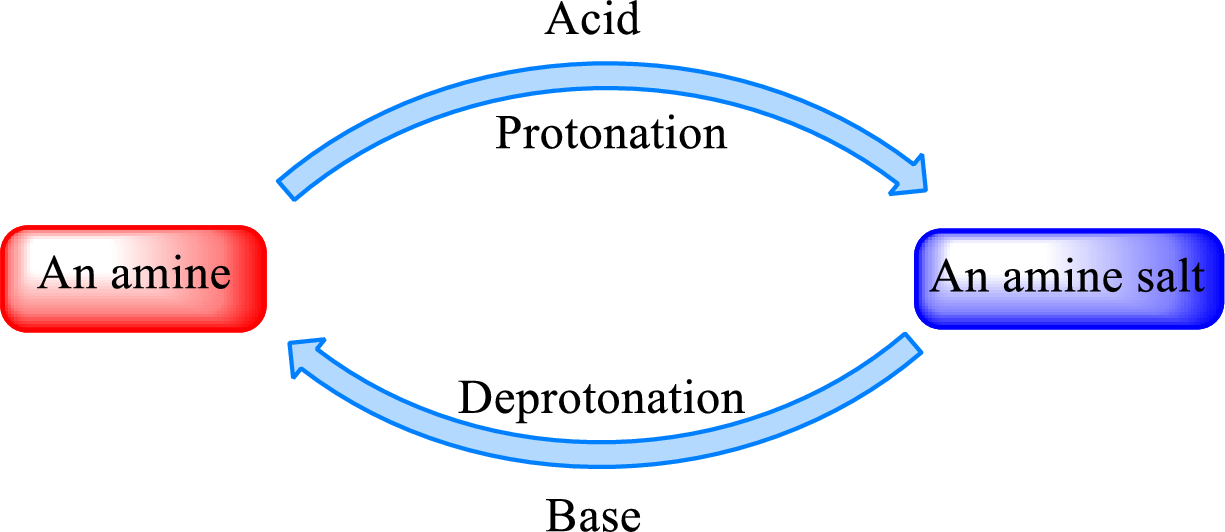
Concept explainers
(a)
Interpretation:
“Parent” amine can be regenerated from the given salt or not has to be indicated.
Concept Introduction:
Quaternary ammonium salt is the one that has four carbon atoms attached to the nitrogen atom. This is formed by the reaction of tertiary amine with
Neutralization reaction is the one that takes place between an acid and a base to give salt as product. As
When a strong base is added to the amine salt, the parent amine can be obtained. This is a reverse reaction of the amine salt formation reaction. These reactions can be represented as shown below,

Quaternary ammonium salt does not give the “parent” amine when treated with a strong base as there is no possibility of deprotonation to take place.
(b)
Interpretation:
“Parent” amine can be regenerated from the given salt or not has to be indicated.
Concept Introduction:
Quaternary ammonium salt is the one that has four carbon atoms attached to the nitrogen atom. This is formed by the reaction of tertiary amine with alkyl halide in presence of a strong base.
Neutralization reaction is the one that takes place between an acid and a base to give salt as product. As amines are bases due to the amino group in it, the reaction with inorganic acid or carboxylic acid gives salt as product. The salt formed is an amine salt. Proton is donated from the acid to the nitrogen atom which acts as a proton acceptor. In simple words, it can be said that in an amine‑acid reaction, the acid loses a hydrogen ion and amine gains a hydrogen ion.
When a strong base is added to the amine salt, the parent amine can be obtained. This is a reverse reaction of the amine salt formation reaction. These reactions can be represented as shown below,

Quaternary ammonium salt does not give the “parent” amine when treated with a strong base as there is no possibility of deprotonation to take place.
(c)
Interpretation:
“Parent” amine can be regenerated from the given salt or not has to be indicated.
Concept Introduction:
Quaternary ammonium salt is the one that has four carbon atoms attached to the nitrogen atom. This is formed by the reaction of tertiary amine with alkyl halide in presence of a strong base.
Neutralization reaction is the one that takes place between an acid and a base to give salt as product. As amines are bases due to the amino group in it, the reaction with inorganic acid or carboxylic acid gives salt as product. The salt formed is an amine salt. Proton is donated from the acid to the nitrogen atom which acts as a proton acceptor. In simple words, it can be said that in an amine‑acid reaction, the acid loses a hydrogen ion and amine gains a hydrogen ion.
When a strong base is added to the amine salt, the parent amine can be obtained. This is a reverse reaction of the amine salt formation reaction. These reactions can be represented as shown below,

Quaternary ammonium salt does not give the “parent” amine when treated with a strong base as there is no possibility of deprotonation to take place.
(d)
Interpretation:
“Parent” amine can be regenerated from the given salt or not has to be indicated.
Concept Introduction:
Quaternary ammonium salt is the one that has four carbon atoms attached to the nitrogen atom. This is formed by the reaction of tertiary amine with alkyl halide in presence of a strong base.
Neutralization reaction is the one that takes place between an acid and a base to give salt as product. As amines are bases due to the amino group in it, the reaction with inorganic acid or carboxylic acid gives salt as product. The salt formed is an amine salt. Proton is donated from the acid to the nitrogen atom which acts as a proton acceptor. In simple words, it can be said that in an amine‑acid reaction, the acid loses a hydrogen ion and amine gains a hydrogen ion.
When a strong base is added to the amine salt, the parent amine can be obtained. This is a reverse reaction of the amine salt formation reaction. These reactions can be represented as shown below,

Quaternary ammonium salt does not give the “parent” amine when treated with a strong base as there is no possibility of deprotonation to take place.
Want to see the full answer?
Check out a sample textbook solution
Chapter 17 Solutions
EBK GENERAL, ORGANIC, AND BIOLOGICAL CH
- With the given structures, arrange the following compounds in order of decreasing reactivity towards hydrolysisarrow_forwardIn a paragraph form, provide the experimental procedures of the development of the ring structure of α-tetralene by elimination of the water molecule will result in this product being heated in the presence of strong sulphuric acid.arrow_forwardGlycine hydrochloride (Cl− H3N+CH2COOH) is a diprotic acid that contains a carboxylic acid group and an ammonium group and is therefore called an amino acid. It is often used in biochemical buffers. Solve, In analogy with Figure , sketch the titration curve of this diprotic acid.arrow_forward
- Histidine has three ionizable groups. On the titration curve below, show: a) 2 molar equivalents of OH b) pka of the third ionizable group Histidine Titration 12.0 10.0 8.0 4 pH 6.0 4.0 2.0 0.0 Equivalents OHarrow_forwardPropanamide and methyl acetate have about the same molar mass, both are quite soluble in water, and yet the boiling point of propanamide is 486 K, whereas that of methyl acetate is 330 K. Explain.arrow_forwardThe ionization of p-nitrophenol is shown below (pKa = 7.0): a. Identify the weak acid and conjugate base. b. At pH 7, what are the relative concentrations of ionized and un-ionized p-nitrophenol? c. If enough concentrated hydrochloric acid is added to a solution of p-nitrophenol to lower the pH from 7 to 5, what will happen to the relative concentrations of the ionized and un-ionized forms? d. Ionized p-nitrophenol has a yellow color, while the un-ionized form is colorless. The yellow color can be measured using a spectrophotometer at 400nm. In order to determine the total amount of p-nitrophenol in a solution, would you perform the spectrophotometer reading at an acidic or basic pH? Clearly explain why? e. A solution of p-nitrophenol at pH 7.95 was found to have an A400 of 0.255 . What is the total concentration (in µM) of p-nitrophenol (ionized plus un-ionized) in the solution? The molar extinction coefficient of p-nitrophenol is 18,500 M-1cm-1 and the pKa is 7.arrow_forward
- A 100 mL solution of 0.1 M glycine at pH 1.72 was titrated with 2 M LIOH. The pH was monitored and the result were plotted as shown in the graph. The key points of the titration are designated as I to V. Identify the key point in the titration corresponding to the pH at which the carboxyl group is half deprotonated. 12 JL30 (V) 9.60 (IV) 8 5.97 pH 6 2.34 CII) 2 (I) 0.5 1.0 1.5 2.0 OH (equivalents) IV O Il and IV Nextarrow_forwardTrans-oleic acid (18:1,D9) has a melting temperature of (44.5C) and cis-oleic acid (18:1,D9) has a melting point of (13.4C). Briefly explain the difference in melting points between the two. tw.arrow_forwardConsider the following acids and their ionization constant, determine which conjugate base is HCOOH Ka = 1.7 x 10-4 (b) HCN Ka = 4.9 x 10-10arrow_forward
- Determine the weight/volume of the chemicals needed to prepare the following solutions: a) 100 ml of 0.9% (w/v) saline (NaCl) b) 30 ml of 50% glycerol (v/v) c) Electrophoresis requires TAE, which is a specific mixture of Tris base, acetic acid, and EDTA. TAE is normally made as a 50X concentrated stock. Provide a recipe to make 40 ml of 50X TAE. The recipe for one liter of 50X TAE is as follows: 242g Tris base, 57.1 ml glacial acetic acid, 100 ml 0.5 M EDTAarrow_forwardModify the Fischer projection of the following aldose to show the compound that is formed when the aldose is treated with H2 in the presence of a Pd catalyst. CHO H -OH HO H H .OH CH₂OH X :ロ Garrow_forwardA base is added to a 0.050 M solution of MnCl2, raising the pH gradually. Calculate the pH of the solution when 70 of the manganese has precipitated? Table 5-7 Solubility-Product Constants, K, at 25°C Fluorides Chromates (cont.) Ag, Cro, PbCro, Hydroxides (cont.) Ni(OH), Zn(OH), Cu(OH), Hg(OH)2 Sn(OH), Cr(OH), Al(OH), Fe(OH), Co(OH), Sulfides Baf, MGF2 PbF, SrF, CaF, 2.4 x 10-6 1.9 x 10-12 1.6 x 10-16 8 x 10-8 X 10-8 7.9 x 10-10 3.9 x 10-11 2 x 10-16 4.5 X 10-17 4 1.6 x 10-19 X 10-26 X 10-27 6.7 x 10-31 Carbonates NiCO, CaCO, BaCO, SrCO, CuCO, ZnCO, MNCO, FeCo, Ag,CO, CdCo, PbCO, M9CO, Hg,CO, 1.4 X 10-7 4.7 x 10-9 3. Chlorides 1.6 x 10-9 PbCl, AgCI Hg,Cl, х 10-33 X 10-38 2.5 x 10-43 1.6 x 10-5 X 10-10 2.5 x 10-10 2 x 10-1o 8.8 x 10-11 2.1 X 10-11 7 1.7 x 10-10 1.1 X 10-18 6. Bromides PbBr2 X 10-16 X 10-19 X 10-21 5 x 10-22 2.5 x 10-22 X 10-26 1.0 x 10-28 MnS 4.6 x 10-6 5.0 x 10-13 Fes 4. AgBr Hg,Br, 8.2 x 10-12 NiS Cos Zns 1.3 x 10-22 3 5.2 x 10-12 1.5 x 10-15 1 x 10-15 9.0 x 10-15…arrow_forward
